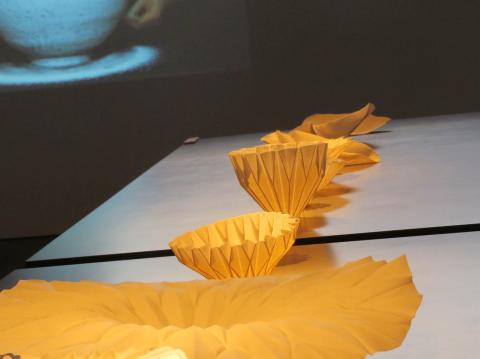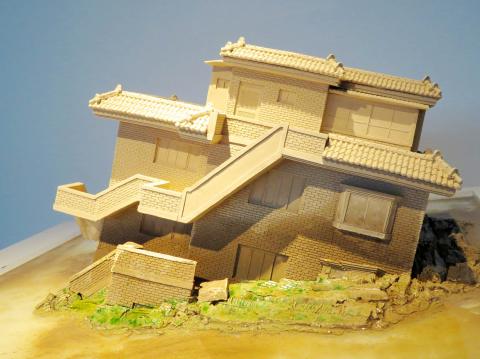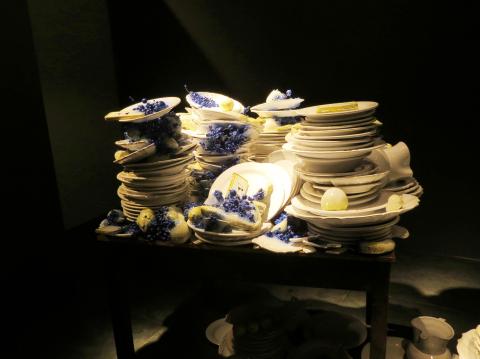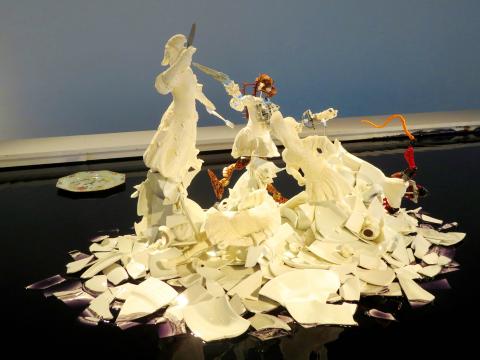It turns out that desktop printers are good for more than printing invoices — they can also make a pretty serviceable ceramic brick.
Architect Brian Peters has developed a way to make ceramic bricks using a portable desktop printer. He fits it with a custom-built extrusion head, which acts like a frosting pipette and spews a special earthenware blend. The contraption creates a funny-looking honeycomb-shaped brick that interlocks, a sculpture that is currently on display at the Taiwan Ceramics Biennale.
Peters is one of 58 artists featured at the biennale, an international exhibition that Yingge Ceramics Museum has hosted since 2004.

Photo: Enru Lin, Taipei Times
Curated by Wendy Gers, this edition is called Terra-Nova: Critical Currents/Contemporary Ceramics.
NEW TRENDS

Photo: Enru Lin, Taipei Times
The format is unpretentious and cool, made up of just four galleries titled after up-and-coming trends in the field: ceramics art that tries actively to preserve local heritage, 3D-printed ceramics, recycled ceramics and digital ceramics.
In the gallery on heritage ceramics, Juree Kim presents a tribute to neighborhoods that are disappearing in South Korea due to urban renewal. It’s a white clay house that is slowly and barely perceptibly receding into a pan as it absorbs water. By October, the building will be gone.
Nearby, there’s Japanese “porcelain origami” by newcomer Hitomi Igarashi.

Photo: Enru Lin, Taipei Times
Igarashi, a finalist in the 2012 international Lexus Design Award, invented a process for creating paper-thin porcelain. She heats and pours porcelain into a paper mold and fires it at 1,250 degrees Celsius. The paper burns away, resulting in an ultra-thin cup that is both hard and delicate.
Using a similar technique, Taiwanese artist Peng Shao-hsiang (彭紹翔) turns boys’ and girls’ school uniforms into clay art. Ten uniforms are covered with clay and then fired, achieving true-to-size white shirts and shorts with a comfortable lived-in look, Peng said.
BIG NAME CERAMICISTS

Photo: Enru Lin, Taipei Times
Some of the featured works are by today’s biggest names in ceramics fine art.
Dutch artist Bouke de Vriesa, one of the world’s leading ceramics conservators, presents War & Pieces, a stunning series of porcelain-shard sculptures including one of a mushroom-shaped atomic-bomb cloud. Like all of De Vriesa’s pieces, this one was made using donated pieces of damaged ceramics.
Pierluigi Pompei’s Whispers is a digital sculpture with five tremendous ceramic trumpets. Each emits a different set of painstakingly arranged sounds that interact with the others and change as the listener moves between them.
Since its opening in May, Terra-Nova: Critical Currents/Contemporary Ceramics has drawn over 210,000 visitors, said director Chen Chun-lan (陳春蘭) of the Yingge Ceramics Museum.
The exhibition offers English and Chinese-language panels and audio tours and runs at the Yingge Ceramics Museum in New Taipei City until Oct. 12.

That US assistance was a model for Taiwan’s spectacular development success was early recognized by policymakers and analysts. In a report to the US Congress for the fiscal year 1962, former President John F. Kennedy noted Taiwan’s “rapid economic growth,” was “producing a substantial net gain in living.” Kennedy had a stake in Taiwan’s achievements and the US’ official development assistance (ODA) in general: In September 1961, his entreaty to make the 1960s a “decade of development,” and an accompanying proposal for dedicated legislation to this end, had been formalized by congressional passage of the Foreign Assistance Act. Two

Despite the intense sunshine, we were hardly breaking a sweat as we cruised along the flat, dedicated bike lane, well protected from the heat by a canopy of trees. The electric assist on the bikes likely made a difference, too. Far removed from the bustle and noise of the Taichung traffic, we admired the serene rural scenery, making our way over rivers, alongside rice paddies and through pear orchards. Our route for the day covered two bike paths that connect in Fengyuan District (豐原) and are best done together. The Hou-Feng Bike Path (后豐鐵馬道) runs southward from Houli District (后里) while the

March 31 to April 6 On May 13, 1950, National Taiwan University Hospital otolaryngologist Su You-peng (蘇友鵬) was summoned to the director’s office. He thought someone had complained about him practicing the violin at night, but when he entered the room, he knew something was terribly wrong. He saw several burly men who appeared to be government secret agents, and three other resident doctors: internist Hsu Chiang (許強), dermatologist Hu Pao-chen (胡寶珍) and ophthalmologist Hu Hsin-lin (胡鑫麟). They were handcuffed, herded onto two jeeps and taken to the Secrecy Bureau (保密局) for questioning. Su was still in his doctor’s robes at

Mirror mirror on the wall, what’s the fairest Disney live-action remake of them all? Wait, mirror. Hold on a second. Maybe choosing from the likes of Alice in Wonderland (2010), Mulan (2020) and The Lion King (2019) isn’t such a good idea. Mirror, on second thought, what’s on Netflix? Even the most devoted fans would have to acknowledge that these have not been the most illustrious illustrations of Disney magic. At their best (Pete’s Dragon? Cinderella?) they breathe life into old classics that could use a little updating. At their worst, well, blue Will Smith. Given the rapacious rate of remakes in modern